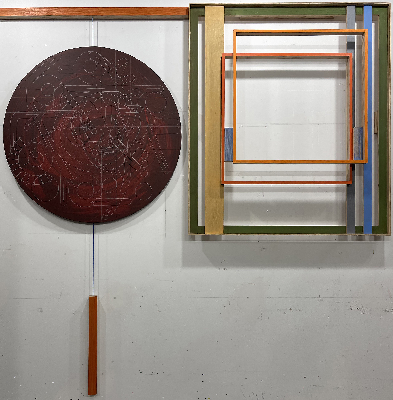Medium: Painting
Studio Location:
LIC Art Center - Studio# 310
44-02 23rd Street
Artist Bio:
ANDREW LYGHT
Born 1949, Georgetown, Guyana
Andrew Lyght's works combine drawing, painting, sculpture, and installation art.
Through matching industrial elements with vibrant colors and smooth geometric
Shapes, Lyght transforms hard-edge, functional construction objects into artworks,
that are graceful and lyrical.
Lyght has received awards from the Adolph and Esther Gottlieb Foundation in 2010
And the Barnett and Annalee Foundation in 2004. He was an Artist-in-Residence at
MoMA P.S. 1 during 1978-1980. His work included in the 2010 Global Africa Project
at the Museum of Arts and Design, New York, Andrew Lyght had a retrospective in
2016 at the Samuel Dorsky Museum of Art at the State University of New York, New
Paltz. Other museum installations include Andrew Lyght#-d Painting at the Nassau
County Museum of Fine Art, Roslyn, New York in 1984 and Painting Structure at the
Smith College Museum of Art, Northampton Massachusetts in 1983.
Lyght work is included in prestigious collections the Centre Georges Pompidou,
Paris, the Samuel Dorsky Museum of Art, New Platz, New York, the Jewish Museum,
New York, the World Bank Art Program, Washington, D.C., the Studio Museum in
Harlen, New York, the Smith College Museum of Art Northampton, Massachusetts,
and the Canada Council Art Bank, Canada.
Artist Statement:
"Line Weights in Pictures"
Over the years, the study and exploration of "Line", whether drawn, painted, or created tension structures with cords as line, lengths of wood or square steel tube to frame space has been at the center of my creative practice. My inquiries into this most basic of visual elements and the different way it operates in the visual arts, physically and expressively has been extensive. My latest body of artwork titled "Line Weights" is a continuation of the idea and my belief that the formal elements of drawing, painting, and sculpture, particularly line and plane, can be separated into both graphic and physical components, moved around, manipulated in space to create voids, volume, and mass within an open-picture frame.
Using this approach in my art making my intent is not to destroy, but expand the concept of painting, by offering a new, exciting, and more flexible form of built geometric abstraction in which line operates both as a graphic element and a structural form within the same picture. These works notably feature the placement of an architectural lintel member provides structure, using a cord to pull a vertical line off it forming a T-shaped line-frame. Positioned at the top next to a portrait view open-picture frame making it a diptych. First half a horizonal allowed pulling of a line off it extending to a flat-solid figure along the vertical length, attached to a broken end post. while the mass weight gravitational force creates plumb line. The second half an open-picture frame incorporates the surface area of wall as a ground plane. This use of cord as line is integrated into the structure adding volume and depth to the painting.
This concept of wall-built geometric abstraction integrating the use of cord as line is a direct outgrowth of a ceiling suspension system that I developed in the 1970s and 80s as a way of extending hand-drawn pencil line, pulling it into three-dimensional space of a room. The use of line then shifted to making free-hand drawings on the cylindrical surface of a recycled industrial discarded 55-gallon drum transforming into a work of art that hung perpendicular on a white wall creating volume within a steel open-frame or positioned on the top of a boxlike line-frame upright forming a columnlike broken structure with marking on the surface placed on the of a room. The aim of this concept was to blur boundaries of drawing, painting, and sculpture into a unified whole.
Andrew Lyght,
 
All images and text copyright Andrew Lyght
|
 |

